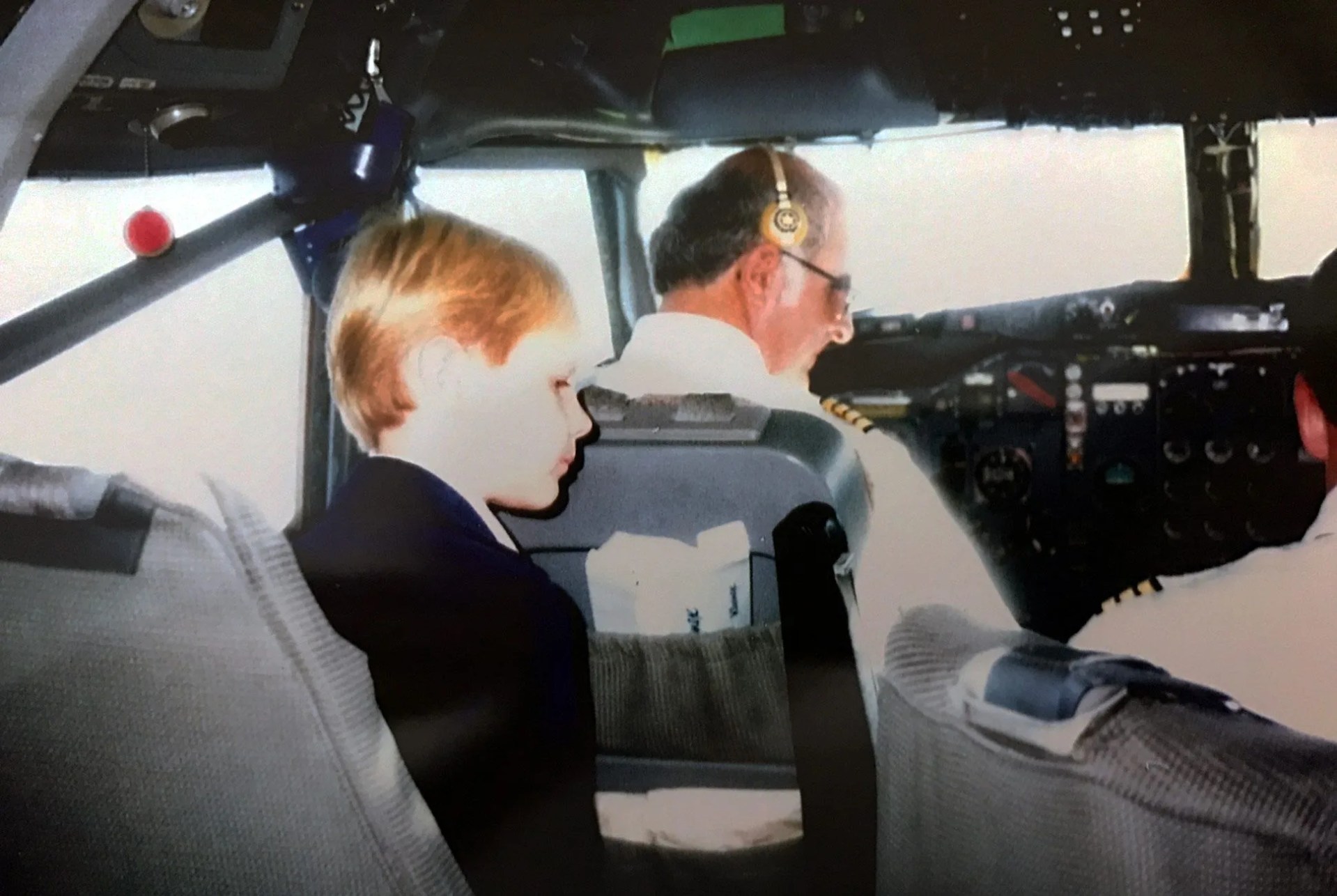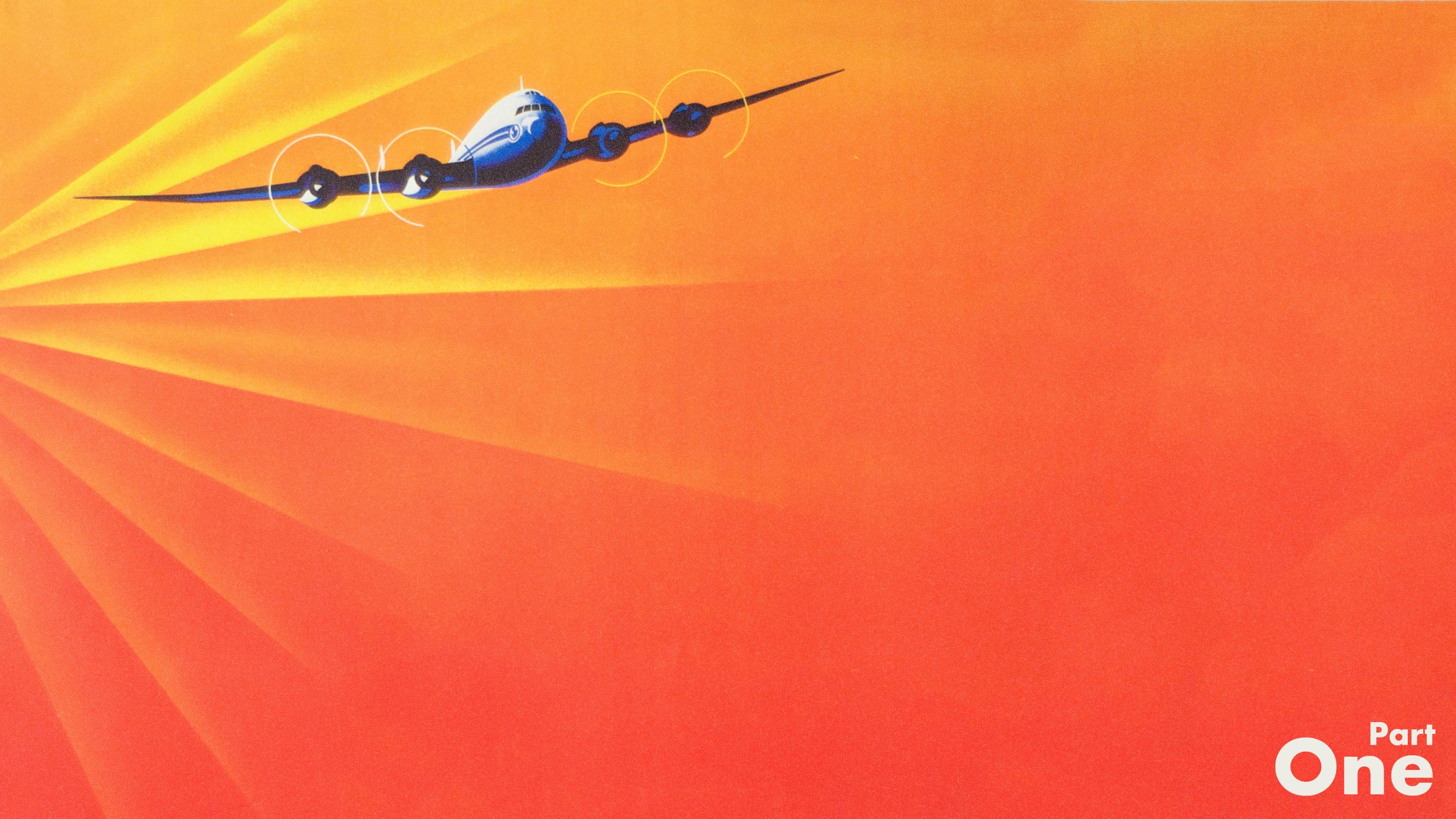Editor’s Note: This post is part one of a three-part series about learning to fly by Mike Arnot, founder of men’s design brand Boarding Pass NYC (formally Owen & Fred), a writer and now a licensed pilot. We’re excited to share Mike’s story, and hope you might become inspired if you’ve ever wanted to take to the skies. Check out all three installments here.
In 1988, flying on a commercial airliner was much different than it is today. At that time, if the flight was long enough, and the captain of the plane was willing, a ten-year-old kid like me could be escorted with their dad to the very front of the plane during the flight itself. You’d get a set of captain’s wings to pin to your jacket and a great memory. I had this opportunity on my first “airplane ride,” and it was a thrilling introduction to flight. Unlike most other kids, though, I actually got to make the plane move. I barely remember the rest of that vacation but can recall every moment of the 15 minutes I spent on the flight deck.
It was an Air Canada Boeing 727-200, complete with a captain, a first officer and a navigator. The door opened to a surprisingly bright, loud and drafty flight deck, compared to the comfort of the rear of the bus. I could feel the minus 60-degree air flowing in from somewhere. The view of the soft, white clouds ahead with Canadian prairie below was astounding. (Pilots, as it turns out, have the best views.) My dad snapped some photos.
“Give me your hand,” the captain said authoritatively. He was the archetype of a pilot and flew in the military for a time.
I put out my hand cautiously. He grabbed my fingers and put them on a random dial floating aimlessly in a sea of dials and switches. He twisted my fingers to the right. Immediately, and very perceptibly, the Boeing began a gentle bank to the right. Under “my” control. We did it again, this time to course-correct back to the left. I made the plane bank, and I’ll remember it forever.
Fast forward to 2016. I’ve had the chance to make a plane move again, this time without a copilot. Late last year, I took what was simply a passing interest in aviation a step further, and decided to become a private pilot. I’m moving from the back of a big plane to the front of the plane, albeit a small one. (It’s still pretty drafty.)
And, not unlike that giddy ten-year-old version of me, on December 13, 2016, I flew a 2,000 pound Cessna Skyhawk into the sky. I was the pilot-in-command of this plane, and I flew her alone for the first time.
This is the story of why I’m learning to fly. Perhaps you’ll read this, and join me in the ranks of those who can.

Why Fly a Plane?
Today, many passengers view commercial air travel as simply a flying Greyhound. It’s a routine event complete with long lines of terrible people, spotty wi-fi aloft, and airline points that never seem to amount to much. Personally, I’ve been folded in half and inserted into many a crusty airline seat.
But for me, these inconveniences are far outweighed by the thrilling power of the engines spooling for takeoff, the incredible views that go by the window at 35,000 feet, and the simple fact that these beasts carve the skies floating on a cushion provided by an invisible fluid: air.
I love flying for the sake of flying, and not simply as a means to take you somewhere exotic, or Buffalo. When I was a boring corporate lawyer, a work trip to Boston would get me out of the office, away from email, and up in the air. My face was glued to the window for the entire flight. Today, when I see an Instagram post of a pilot’s view from an airplane window, I know that they too understand the beauty of flight. I’ll live vicariously through them for a moment, and enjoy their view.
You can’t control the view, however, unless you’re a pilot.
My transition from the back of the plane to the front of the plane really took off with a well-known flight simulator called X-Plane, first on the iPad version. It’s a fun distraction — more serious than Call of Duty, but not quite with the consequences of actually flying. (My wife still refers to X-Plane as a “video game.”) I’ve never been into video games, but X-Plane was as close to the real thing as I dared to venture.
I bought a yoke and rudder to connect to X-Plane. Then a mock Cessna throttle. Then a trim wheel. As it turns out, simulators like X-Plane are surprisingly realistic. The controls feel very similar to the controls in a Cessna. There is tension in the yoke and the rudder pedals, just like a real plane. Even the graphics can be incredibly realistic. And yet, not so realistic as to provide you with a photo-worthy view.
Soon enough, flying-related books started to pile up at home. In full-on geek mode, I devoured Stick & Rudder, the classic pilot’s book, and the Airplane Flying Handbook from the FAA. My wife knew something was up. It had been a gradual process, from learning how airplanes fly to getting more interested in the real thing. But, at some point last year, I grew bored of flying a simulator and wanted instruction. Despite my wife’s initial objections, I began flight training in August 2016 with a “discovery flight” at a local flight school in New York.
What I and many others discover on a flight is that flying is thrilling and addicting.
The Discovery Flight: Strapping into a Kite
I walked up to the plane — a Cessna 172 Skyhawk — with my instructor and felt immediate dread. To the untrained, the Skyhawk or any general aviation aircraft looks quite light and rickety. Even a Cessna that’s only a few years old is no Boeing 737. You can literally push down on the tail with your hand and make it strike the ground. Compared to a jetliner, it feels like you’re strapping into a kite.
I didn’t enjoy the first takeoff, even though, according to the instructor, I did it myself. (Thanks, X-Plane.) It was steeper and bumpier than I expected. I had the irrational (but real) fear that the air cushion would literally just drop out from under us. It was a momentary fear, though. Once we reached our cruising altitude — a whopping 2,500 feet — I stopped white-knuckle gripping the yoke, relaxed, and was hooked.
Over the next few months, I dove headfirst into the lessons required to develop piloting skills. Learning to fly is a highly regulated process, requiring careful study, several hours of flight time, a few written exams and various checks. I was quite surprised at how rigorous it is, and am glad that it is this way. (Safety first.) It’s as intense as law school. My wife was certainly patient on Sunday afternoons when I had my nose in the books.
It’s All About the View
The first thing friends ask me when they hear I’m learning to fly is: “How is the view?” In truth, for the first months of training, I didn’t get to enjoy the view, or if I did, it was for fleeting moments. Flying requires complete focus on the task at hand. There’s no time to smell the roses. You have to learn the special language of radio calls. You control the altitude and airspeed and are scanning the skies for other planes. Your instructor is constantly challenging you with new scenarios, just when you get comfortable with the last one. You need to re-learn what you forgot from last week.
But in those moments where I have permitted myself to look out the window and take it all in, I realize why I’m learning to fly. The view is truly beautiful, rain or shine. I fly between around 2,000 and 7,000 feet above Long Island, over the ocean and beach. Gorgeous houses and estates line the shoreline. You can see, but not hear, the waves crashing against the shore. Manhattan looms in the distance. It is quiet, and serene for once. In the fall, you get the very best views of the foliage. In the winter, it’s like being in a snow globe. And year round, the ocean sparkles. Flying is one, big, beautiful Instagram photo unfurling all around you.
When I fly, I leave earthly stresses behind. The sun shines red and orange, the sky is deep blue, and you’re alone up there. There’s no one near you. You don’t get cut off, and nobody honks their horn. There is no horn to honk.
And flying itself — the engineering feat that is man aloft — is surprisingly gentle, soft, and graceful. The Skyhawk is incredibly forgiving, and the flights aren’t particularly bumpy. You carve through the air like a surfer cuts a crystal-clear green wave.
If you’ve spent your flying days like I did, glued to the window, know that you can take matters into your own hands. You can fly. I hope you do. Only then will you know how wonderful it is.


